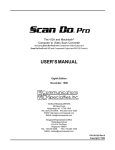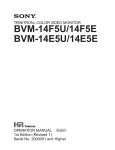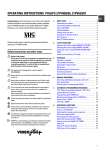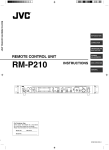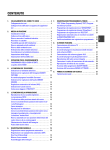Download Black Box AC096A Specifications
Transcript
FEBRUARY 1995 AC095A AC096A ProVideo Converter Video Scan Converter II verter eo Con ProVid IFY MAGN INPUT UNDER SCAN HOME ANTIR FLICKE FREEZE verter II an Con TEST c Video S POWER UNDER SCAN INPUT ANTIR FLICKE FREEZE TEST POWER CUSTOMER SUPPORT INFORMATION Order toll-free in the U.S. 24 hours, 7 A.M. Monday to midnight Friday: 877-877-BBOX FREE technical support, 24 hours a day, 7 days a week: Call 724-746-5500 or fax 724-746-0746 Mail order: Black Box Corporation, 1000 Park Drive, Lawrence, PA 15055-1018 Web site: www.blackbox.com • E-mail: [email protected] FCC AND IC STATEMENTS, TRADEMARKS FEDERAL COMMUNICATIONS COMMISSION AND INDUSTRY CANADA RADIO FREQUENCY INTERFERENCE STATEMENTS This equipment generates, uses, and can radiate radio frequency energy and if not installed and used properly, that is, in strict accordance with the manufacturer’s instructions, may cause interference to radio communication. It has been tested and found to comply with the limits for a Class A computing device in accordance with the specifications in Subpart J of Part 15 of FCC rules, which are designed to provide reasonable protection against such interference when the equipment is operated in a commercial environment. Operation of this equipment in a residential area is likely to cause interference, in which case the user at his own expense will be required to take whatever measures may be necessary to correct the interference. Changes or modifications not expressly approved by the party responsible for compliance could void the user’s authority to operate the equipment. This digital apparatus does not exceed the Class A limits for radio noise emission from digital apparatus set out in the Radio Interference Regulation of Industry Canada. Le présent appareil numérique n’émet pas de bruits radioélectriques dépassant les limites applicables aux appareils numériques de classe A prescrites dans le Règlement sur le brouillage radioélectrique publié par Industrie Canada. TRADEMARKS USED IN THIS MANUAL Apple, Mac, and Macintosh are registered trademarks of Apple Computer, Inc. IBM is a registered trademark of IBM Corporation. RCA is a registered trademark of General Electric Co. UL is a registered trademark of Underwriters Laboratories Incorporated. Any other trademarks mentioned in this manual are acknowledged to be the property of the trademark owner. PROVIDEO CONVERTER AND VIDEO CONVERTER II NORMAS OFICIALES MEXICANAS (NOM) ELECTRICAL SAFETY STATEMENT INSTRUCCIONES DE SEGURIDAD 1. Todas las instrucciones de seguridad y operación deberán ser leídas antes de que el aparato eléctrico sea operado. 2. Las instrucciones de seguridad y operación deberán ser guardadas para referencia futura. 3. Todas las advertencias en el aparato eléctrico y en sus instrucciones de operación deben ser respetadas. 4. Todas las instrucciones de operación y uso deben ser seguidas. 5. El aparato eléctrico no deberá ser usado cerca del agua—por ejemplo, cerca de la tina de baño, lavabo, sótano mojado o cerca de una alberca, etc.. 6. El aparato eléctrico debe ser usado únicamente con carritos o pedestales que sean recomendados por el fabricante. 7. El parato eléctrico debe ser montado a la pared o al techo sólo como sea recomendado por el fabricante. 8. Servicio—El usuario no debe intentar dar servicio al equipo eléctrico más allá a lo descrito en las instrucciones de operación. Todo otro servicio deberá ser referido a personal de servicio calificado. 9. El aparato eléctrico debe ser situado de tal manera que su posición no interfiera su uso. La colocación del aparato eléctrico sobre una cama, sofá, alfombra o superficie similar puede bloquea la ventilación, no se debe colocar en libreros o gabinetes que impidan el flujo de aire por los orificios de ventilación. 10. El equipo eléctrico deber ser situado fuera del alcance de fuentes de calor como radiadores, registros de calor, estufas u otros aparatos (incluyendo amplificadores) que producen calor. 11. El aparato eléctrico deberá ser connectado a una fuente de poder sólo del tipo descrito en el instructivo de operación, o como se indique en el aparato. NOM STATEMENT 12. Precaución debe ser tomada de tal manera que la tierra fisica y la polarización del equipo no sea eliminada. 13. Los cables de la fuente de poder deben ser guiados de tal manera que no sean pisados ni pellizcados por objetos colocados sobre o contra ellos, poniendo particular atención a los contactos y receptáculos donde salen del aparato. 14. El equio eléctrico debe ser limpiado únicamente de acuerdo a las recomendaciones del fabricante. 15. En caso de existir, una antena externa deberá ser localizada lejos de las lineas de energia. 16. El cable de corriente deberá ser desconectado del cuando el equipo no sea usado por un largo periodo de tiempo. 17. Cuidado debe ser tomado de tal manera que objectos liquidos no sean derramados sobre la cubierta u orificios de ventilación. 18. Servicio por personal calificado deberá ser provisto cuando: A: El cable de poder o el contacto ha sido dañado; u B: Objectos han caído o líquido ha sido derramado dentro del aparato; o C: El aparato ha sido expuesto a la lluvia; o D: El aparato parece no operar normalmente o muestra un cambio en su desempeño; o E: El aparato ha sido tirado o su cubierta ha sido dañada. PROVIDEO CONVERTER AND VIDEO CONVERTER II Contents Chapter Page 1. Specifications ............................................................................................. 1 2. Introduction ............................................................................................... 4 3. Installation .................................................................................................. 3.1 Initial Steps .......................................................................................... 3.2 Hooking Up Video Output ................................................................ 3.3 Selecting Your Video Standard .......................................................... 3.4 Booting Your Converter System ......................................................... 4. Operation ................................................................................................... 8 4.1 Indicators ............................................................................................. 9 4.2 Using the Front-Panel Controls ......................................................... 9 4.3 Other Features .................................................................................. 11 5. What to Expect from Converted Computer Images .............................. 13 6. Troubleshooting ...................................................................................... 6.1 Common Concerns ........................................................................... 6.2 Calling Your Supplier ....................................................................... 6.3 Shipping and Packaging ................................................................... 5 5 5 7 7 15 15 17 17 Appendix A: S-Video, the Improved-Quality Video Standard ...................... 18 Appendix B: Connector Pinouts .................................................................... 19 CHAPTER 1: Specifications 1. Specifications Approvals — FCC Part 15 Class A, IC Class/classe A System Software Required — None Standards — Input, Computer Output: VGA, SVGA, or Mac video at the refresh rates and resolutions listed below; Television Output: NTSC or PAL composite, S-Video (including Hi-8 and Beta-ED), and/or RGBS Compatibility — All operating systems and environments Color — Up to 24-bit (“true”) color (16.8 million colors) Refresh Rates and Resolutions — ProVideo Converter (AC095A): VGA, SVGA: 320 x 200, 640 x 200, and 640 x 350 at 70 Hz; 640 x 480 at 60, 72, 73, or 75 Hz; 720 x 350 and 720 x 400 at 70 Hz; 800 x 600 at 56, 60, 70, 72, 73, and 75 Hz; 1024 x 768 at 60, 70, 72, 73, and 75 Hz; Mac: 640 x 480 at 66 Hz; 832 x 624 at 75 Hz; 1024 x 768 at 60 Hz; Video Converter II (AC096A): VGA, SVGA: 320 x 200, 640 x 200, and 640 x 350 at 70 Hz; 640 x 480 at 60, 72, 73, or 75 Hz; 720 x 350 and 720 x 400 at 70 Hz; 800 x 600 at 56, 60, 70, 72, 73, and 75 Hz; Mac: 512 x 384 at 60 Hz; 640 x 480 at 66 Hz; 832 x 624 at 75 Hz 1 PROVIDEO CONVERTER AND VIDEO CONVERTER II Computer- and TVVideo Processing — Input Sampling: 24-bit (8 bits per RGB), 708 samples per active portion of computer-video line; Graphics-Mode Detection: Automatic; Video Processing: 24-bit separate RGB; Video-Memory Size: 708 x 740 x 24 bits (1 video frame); Video-Encoding Process: 24-bit RGB encoding with 10-bit output D/A; RGB Output Processing: 24-bit RGB with 3 x 8-bit output D/A; Differential Gain: Less than 1%; Differential Phase: Less than 1˚; Frequency response for composite, S-Video: 6.5 MHz (–3 dB) User Controls — (9 [AC096A] or 10 [AC095A]) External: (1) Rear-mounted slide switch for NTSC/PAL selection; (8 [AC096A] or 9 [AC095A]) Front-mounted pushbuttons: Both models: (1) Underscan, (1) Flicker Reduction, (1) Freeze Image, (1) Test, (4) Image Positioning; AC095A only: (1) Magnify Indicators — (6 [AC096A] or 7 [AC095A]) Front-mounted LEDs: (2) on panel: Power, Input; (4 [AC096A] or 5 [AC095A]) on buttons: Both models: Underscan, Flicker Reduction, Freeze Image, Test; AC095A only: Magnify Connectors — (6) Rear-mounted: (1) DB15 female for VGA input or Mac output; (1) DB15HD female for Mac input or VGA output; (1) RCA phono jack for composite output; (1) 4-pin mini-DIN female for S-Video output; (1) DB9 for RGBS output; (1) Inverted phono jack for power 2 CHAPTER 1: Specifications Power — From UL®, CSA, and TUV certified desktop power supply: Input range: 95- to 250-VAC, 47 to 63 Hz (autosensing) at 0.9 amps; Output: 5 VDC at 5 amps Size — 1.5"H x 7.25"W x 6.25"D (3.9 x 18.5 x 15.9 cm) Weight — 3 lb. (1.4 kg) 3 PROVIDEO CONVERTER AND VIDEO CONVERTER II 2. Introduction Thank you for purchasing the ProVideo Converter or Video Converter II. We are sure you will find it to be a reliable and useful product. You now have the ability to convert your computer monitor’s signal into a form suitable for recording on a VCR, displaying on a conventional TV or video monitor, or integrating into a multimedia production system. And you can do this without installing any boards or software in your computer! Chapters 3 and 4 of this manual show you how to install and operate your Converter. Chapter 5 gives you some guidelines on what you should (and shouldn’t) expect from your converted computer images and explains how to get the best quality of image display. Chapter 6 gives you tips for handling problems that might occur with your Coverter system. Appendix A explains what S-Video is and why it should be used as output from your Converter whenever possible. Lastly, Appendix B shows the pinouts of all of your Converter’s connectors. 4 CHAPTER 3: Installation 3. Installation Follow the procedure outlined in this chapter to install your ProVideo Converter or Video Converter II. 3.1 Initial Steps 1. Disconnect your monitor from the monitor port on your computer. 2. Connect one end of the special 6-foot (1.8-m) input cable provided with the Converter to the monitor port on your computer. (See Section 4.3.3 for more info on this cable.) Plug the other end into the appropriate connector on the rear panel of the Converter: either the one labeled VGA IN if you are taking VGA video from an IBM® PC or compatible or the one labeled MAC IN if you are taking Macintosh® video from an Apple® Macintosh. See Figures 3-1 and 3-2 on the next page. 3. If you want your monitor to continue to display, connect it to the appropriate MONITOR output connector, either VGA OUT or MAC OUT. See the next section for a description of this ouput. 4. Plug the output cord of the power supply provided with the Converter into the connector labeled POWER. Plug the power supply’s input cord into the wall outlet to provide power to the Converter. (If you ever need an AC-line cord specific to another country, call Black Box.) 5. Connect your video equipment to one or more of the Converter’s video outputs (refer to the next section). 5 PROVIDEO CONVERTER AND VIDEO CONVERTER II RGB NTSC S-VIDEO COMPOSITE IN VGA OUT OUT MAC IN POWER PAL NTSC/PAL switch for selecting the appropriate video standard Highest-quality RGBS output S-Video output with separate, clearer Y/C video signals Either VGA video input from computer or Macintosh video output for local Mac monitor Composite video ouput for standard video equipment Power supply (line cord from transformer plugs in here) Either Macintosh video input from computer or VGA video output for local VGA monitor NOTE: All outputs are available at the same time. You don’t have to terminate unused outputs. Figure 3-1. Rear panel shared by the ProVideo Converter and Video Converter II. 3.2 Hooking Up Video Output Now connect one or more of the Converter’s output ports to your video equipment: COMPOSITE (RCA® jack): You can feed this single composite-video output signal into the “video” input jacks on ordinary TVs, monitors, VCRs, or professional video equipment. It cannot be connected to the “antenna” input. S-VIDEO (4-pin mini-DIN female): Called S-Video, S-VHS, or Y/C, this output is an advanced form of video which carries the brightness and color parts of images on two separate signals. It is compatible with the Hi-8 and Beta-ED standards. Feed it into compatible equipment by using the included S-Video cable and you’ll get a better-quality picture than the COMPOSITE output can provide. RED, GREEN, BLUE, SYNC (DB9 female): This premium-quality output, which can be used by some video projectors and monitors, consists of separate red, green, blue, and sync signals. If you’d like to use this output with compatible equipment, call your supplier for a special quote on RGBS cable with a male DB9 connector on one end and male BNC connectors, European SCART connectors, or connectors for Sharp LCD projectors on the other end. All outputs are available at the same time. You don’t have to terminate unused outputs. 6 CHAPTER 3: Installation 3.3 Selecting Your Video Standard Use the NTSC/PAL slide switch on the back of your Converter to choose which standard you’ll use for the VIDEO, S-VIDEO, and RGB outputs. NTSC is the video standard for the USA, Canada, Mexico, Japan, and parts of South America. PAL is used throughout most of Europe, the Middle East, Southern Asia, and the Pacific Rim. 3.4 Booting Your Converter System If you haven’t already done so, plug in and turn ON your computer. The green indicator labeled LOCK on the Converter’s front panel should light, showing that the Converter is receiving a proper signal from the computer. (Refer to Chapter 5 for more information about this indicator.) Make sure the FREEZE IMAGE switch on the front panel is in the NORMAL position, so that your computer-image sequences will flow smoothly. Your ProVideo Converter or Video Converter II is now ready for normal operation. 7 PROVIDEO CONVERTER AND VIDEO CONVERTER II 4. Operation The ProVideo Converter and Video Converter II are designed for ease of use, reliability, intelligence, and high performance. We hope you’ll find that using your Converter is pretty simple, especially since there are few controls to adjust and no hidden DIP switches to set. However, we suggest you read this chapter carefully so you can fully understand how your Video Converter operates and can take advantage of all its features. Figure 4-1, below, shows the front panels of the ProVideo Converter and Video Converter II with their buttons and indicators. ProVideo Converter INPUT TEST MAGNIFY POWER Outputs test patterns when TEST is pressed / lit Receiving power when POWER is lit; input signal from computer is OK when INPUT is lit UNDER SCAN HOME Outputs enlarged portion of image when MAGNIFY is pressed / lit; outputs center/ corner portions when HOME is pressed ANTIFLICKER FREEZE Anti-flicker filter is active when ANTI-FLICKER is pressed / lit Moves image when Image is “shrunk” in both IMAGE POSITIONING the horizontal and vertical ARROWS directions when are pressed UNDERSCAN is pressed / lit Image is “frozen” on the screen when FREEZE is pressed / lit Video Scan Converter II INPUT TEST UNDER SCAN ANTIFLICKER FREEZE POWER Figure 4-1. The front panels of the ProVideo Converter and Video Converter II. 8 CHAPTER 4: Operation 4.1 Indicators Most of the Converter’s indicators are mounted in, and function in concert with, its front-panel pushbuttons; these indicators are described in the next section. There are also two independent LEDs mounted in the front panel: POWER: This indicator lights when your Converter is ON (receiving DC power through its external power supply). If this light is glowing dimly or not at all, there might be something wrong with the power supply. See Chapter 6. INPUT: This indicator lights when the Converter is receiving a valid computer signal through the VGA IN or MAC IN connector on its rear panel. For a list of all the combinations of VGA and Mac® display resolutions and vertical refresh rates that the ProVideo Converter or Video Converter II supports, see the Resolutions and Refresh Rates specification in Chapter 1. If the Converter does not detect one of these resolution/refresh rate combinations on its input, it will output a flat blue screen (see Section 4.3.1). 4.2 Using the Front-Panel Controls TEST BUTTON: This button will force your Converter to generate one of two test signals on its COMPOSITE and S-VIDEO outputs. (These test signals are not available on the RGBS output.) When you press this button once, the indicator LED on the button will light up and the Converter will output a “color bar” signal. When you press this button a second time, its LED will stay lit, but the Converter will now output a “grayscale ramp.” When you press this button a third time, the LED will go off and the Converter will resume outputting images received from your computer. NOTE If the TEST button is pressed in continuously for 5 seconds, the Converter will automatically reset itself to its default power-up state. UNDERSCAN BUTTON: When this button has not been pressed, images that the Coverter outputs in composite, S-Video, and RGBS formats will fill the entire viewable screen area. But because some monitors “overscan” their screens, some desirable parts of your images could be cropped off the screen. If this happens, press this button to shrink the images, both horizontally and vertically, approximately 10% in size. (The button’s green LED will light.) Press the button again to restore the images to their original sizes; the LED will go dark. 9 PROVIDEO CONVERTER AND VIDEO CONVERTER II ANTI-FLICKER BUTTON: When this button has not been pressed, the Converter sends images using fully interlaced composite, S-Video, and RGBS video signals. However, thin horizontal lines in the images might appear to “flicker” on and off at a very fast rate. If this happens, you can use this button to activate one of two levels of flicker reduction. When you press this button once, its green light will flash once and stay lit, indicating that “level 1” of flicker reduction is active. Level 1 may still show some flicker but will preserve a greater amount of detail than level 2. Use level 1 unless you still find the flicker annoying. When you press this button a second time, its green light will flash twice and stay lit, indicating that “level 2” of flicker reduction is active. Level 2 will completely eliminate the flicker but will also reduce the detail in the image. Press the button a third time to turn off the anti-flicker filter; the LED will go dark. FREEZE BUTTON: If you want to freeze a frame of an image sequence on the screen without stopping your computer application, press this button: The image on the Composite, S-Video, and RGBS outputs will be frozen and the button’s green LED will light. When you press this button again, the Converter will resume outputting images received from your computer and the LED will go dark. IMAGE-POSITIONING ARROWS: TV monitors and video projectors may not always display the image in the center of the screen even when it is underscanned. The Converter has four buttons that allow you to move the displayed image up, down, left, and right to properly position it in the center of the screen. Each time you press one of these arrows, the image will be moved one increment in the corresponding direction. If you press and hold an arrow down, the Converter will move the image continuously, slowly at first, then quickly. MAGNIFY BUTTON (ProVideo Converter only): Pushing this button will magnify the image from your computer by approximately 160%. When you first press the button, the button’s green LED will light and the upper lefthand corner of the computer image will fill the full screen of the ProVideo Converter’s output. 10 CHAPTER 4: Operation By using the four positioning arrows, you can show any magnified portion of the original computer image. You can also move the display by pressing the HOME (UNDERSCAN) button: Each time you press it, the display will move to a different portion of the image: First time: Center Second time: Upper left-hand corner Third time: Lower left-hand corner Fourth time: Lower right-hand corner Fifth time: Upper right-hand corner Sixth time, etc.: (Cycle repeats) To restore the image to its original size, either press the MAGNIFY button again or press the TEST button. The MAGNIFY LED will go dark. 4.3 Other Features 4.3.1 THE BLUE SCREEN From time to time the Converter might output a blue screen, either momentarily or continuously. The ProVideo Converter and Video Converter II automatically produce this blue screen under any one of the following conditions: • Output flashes blue briefly: Your computer temporarily changes resolutions while running a program. • Output continuously blue: There is no input signal from the computer. • Output continuously blue: There is a signal from the computer, but its resolution and/or refresh rate are not supported by the Converter. If you think you shouldn’t be getting a blue screen, make sure one of the above conditions is not occurring. 11 PROVIDEO CONVERTER AND VIDEO CONVERTER II 4.3.2 COMPUTER-DISPLAY RESOLUTION SUPPORT The ProVideo Converter and Video Converter II do their best to determine the pixel resolution (for example, 640 x 480) and the vertical refresh rate (for example, 72 Hz) of every image that comes from your computer. While there are published standards for most of the display modes, some manufacturers of older cards may have chosen to vary slightly from these standards. If you encounter a display mode that matches one of the Resolutions and Refresh Rates listed in Chapter 1, but the Converter does not respond to it, notify your supplier of the problem; tell them the make and model of the computer and video-display card, as well as the display resolution and vertical refresh rate you’re having a problem with. 4.3.3 THE COMPUTER-INPUT CABLE The special cable that connects your computer to your Converter, included with your ProVideo Converter or Video Converter II package, is designed to be compatible with both VGA and Macintosh computers. It is specially wired, and DB15-to-DB15HD adapters cannot be used as substitutes. Until you are used to this cable, it might be a good practice to always plug it into the computer first when you connect or reconnect it, so that you are sure to use the right connector on the Converter. 12 CHAPTER 5: What to Expect from Converted Computer Images 5. What to Expect from Converted Computer Images We have included this section to give you some insight into what you can and should expect computer images to look like once they are converted to standard video. People are sometimes surprised that computer images converted to video do not look as sharp and vivid as they do on the computer monitor. Although this might be somewhat disappointing, it should come as no surprise. Color TV and video monitors, and the conventional video standards they use (NTSC and PAL), have been with us since the 1940s and 50s. When high-resolution computer-graphics standards such as VGA and Mac II were introduced less than a decade ago, new display technologies had been developed to achieve higher detail and sharper colors. But, although many design improvements have been made to TV monitors and VCRs, they are still limited to basic technologies that are 40 years old. Scan converters like the ProVideo Converter and Video Converter II were created to bridge the gap between the dissimilar standards of computer video and conventional video equipment. They work, but the trade-off in the process is that you are taking computer images whose sharpness and detail are clearly visible on today’s monitors and displaying them on TVs, or recording them on VCRs, that can’t do them justice. But all is not lost. There are a few things you can do to get the best image possible on your TV/monitor or recorded on videotape. The tips that follow will all contribute to improved quality of your display and VCR recording. • In the world of video, black, white, and all the shades of gray are not processed the same way as “real colors.” TVs and VCRs process these shades with a minimum of distortion. When it’s possible, consider using grayscale images, because they’ll be much sharper than the equivalent colored images. • The “Christmas Effect” occurs with computer images created by artists who really like the green and red color combination. Nothing looks worse on a TV. Try to avoid saturated colors. 13 PROVIDEO CONVERTER AND VIDEO CONVERTER II • Sometimes graphics look so impressive on a computer monitor that users assume that the process of conversion to TV can’t possibly make the graphics look bad. However, what TVs will actually show, especially if they are displaying a video signal that was “beat up” by a VCR recording, can be ugly. To avoid such nasty surprises, connect a Converter and TV to your computer and view your “televised” graphics while you create them, before you present them. • When you make VCR recordings, use either (1) a “Pro” or “Broadcast” grade, name-brand tape, or (2) an S-VHS (Super-VHS) tape (these will play in standard VHS machines). Also, record using the fastest speed (the speed corresponding to the shortest total time per tape—2 hours on a T-120 cassette). You will have less noise and tape jitter in your recording. • Almost all TVs and video monitors overscan images, resulting in some of the picture being “cropped” off the edges of the picture tube. The Converter’s UNDERSCAN mode will shrink images to compensate for this overscan, which will vary in amount from one TV or monitor to another. But even UNDERSCAN won’t entirely eliminate the problem on some TVs and monitors. To ensure that the useful parts of your images are visible on all normally operating TVs and monitors, keep all text and other informational content at least 5% in from the sides, top and bottom. • By far the most annoying effect that occurs when a computer image is converted to video is “flicker.” This rapid flashing of images’ brightness can appear to be pervasive throughout the screen or localized to one particular area. It is most noticeable on thin horizontal lines, particularly on bright lines against a dark background. It is not seen on computer monitors because all the horizontal lines that make up the image are drawn on the screen in one pass from top to bottom, 60 or 70 times a second. When the same image is converted to video, a single line will only be drawn on the screen either 30 (NTSC) or 25 (PAL) times a second. This rate is not rapid enough to make your brain register each drawing of the line as the same continuous line, so the line appears to flicker. The anti-flicker filter in your Converter employs an advanced design technique to overcome this problem with only a very slight loss in vertical detail. 14 CHAPTER 6: Troubleshooting 6. Troubleshooting The first part of this chapter lists some concerns that commonly arise during operation af the ProVideo Converter and Video Converter II, as well as some possible causes and remedies. The other sections describe the steps you should take if a problem proves intractable. 6.1 Common Concerns If your ProVideo Converter or Video Converter II is doing something wrong, the first thing to try is to press and hold the TEST button on the Converter’s front panel for five seconds. The Converter should turn off all of its special functions (TEST, UNDERSCAN, FREEZE, etc.) and reset itself to its default power-up state. If this doesn’t help, follow the directions under the appropriate heading in this section. If there is no appropriate heading for the problem you’re having, or if the recommended procedures don’t help, call Black Box—see Section 6.2. Nothing works or No computer output or Continuous blue screen. 1. Is the power supply connected and plugged into the AC wall outlet? Check the POWER LED. If it’s lit, go to Step 2. 2. Are the cables running from your computer to the Converter and from the Converter to your video equipment properly connected? If they are, go to Step 3. 3. Do you get color bars or a gray scale when you press the TEST button? If not, call your supplier. If you do, press the TEST button until its LED goes out, then go to Step 4. 4. Is the computer sending out a proper VGA or Mac video signal? Check the green INPUT LED. If it’s lit, try replacing the Converter’s connection to your computer with a direct connection to a compatible monitor. If this monitor’s display looks OK, can the Converter support the resolution and refresh rate of the image the computer is sending? (Check the Resolutions and Refresh Rates spec in Chapter 1.) If the Converter should be able to support your image, call Black Box. 15 PROVIDEO CONVERTER AND VIDEO CONVERTER II No video outputs. 1. Is the LED on the FREEZE button lit? If it is, press the FREEZE button again to restore normal operation. If not, go to Step 2. 2. Is your video equipment set or configured to the proper mode to accept direct video input? If it is, go to Step 3. 3. Is the computer sending out a proper video signal? Check the green INPUT LED. If it’s lit, try replacing the Converter’s connection to your computer with a direct connection to a compatible monitor. If the monitor’s display looks OK, can the Converter support the resolution and refresh rate of the image the computer is sending? (Check the Resolutions and Refresh Rates spec in Chapter 1.) If the Converter should be able to support your image, call Black Box. The edges of the image are being cut off. Is the LED on the UNDERSCAN button lit? If not, press the UNDERSCAN button to shrink the image and use the arrow buttons to position it. If the LED is already lit, or if pressing the UNDERSCAN button doesn’t help, then your TV or monitor has an excessive amount of overscan. If possible, try a different TV or monitor. If this can’t be done or still doesn’t help, call Black Box. Only a closeup on part of the image is being displayed. Are the LEDs on the MAGNIFY or UNDERSCAN buttons lit? If not, or if pressing the button(s) with the lit LED(s) doesn’t help, call Black Box. The color on the TV monitor doesn’t match the color on the computer monitor. Since the picture tube in your computer monitor is different from the one in your TV or video monitor, you might see color differences with certain images. Adjust the COLOR, TINT, BRIGHTNESS, and CONTRAST controls on your TV to help match the colors to those on the computer monitor; the Converter’s built-in test patterns might be helpful. 16 CHAPTER 6: Troubleshooting 6.2 Calling Black Box If you determine that your ProVideo Converter or Video Converter II is malfunctioning, do not attempt to alter or repair the unit. It contains no userserviceable parts. Contact Black Box Technical Support at 724-746-5500. The problem may be solvable over the phone. Before you do, make a record of the history of the problem. We will be able to provide more efficient and accurate assistance if you have a complete description, including: • the nature and duration of the problem. • when the problem occurs. • the components involved in the problem, including the makes and models of the computer, video card, and video equipment. • any particular application that, when used, appears to create the problem or make it worse. • the display resolution and vertical refresh rate of the images you are trying to display. 6.3 Shipping and Packaging If you need to transport or ship your Converter: • Package it carefully. We recommend that you use the original container. • If you are shipping the Converter for repair, include its power supply and its input and output cables. If you are returning the Converter, make sure you include everything you received with the unit. Before you ship, contact Black Box to get a Return Materials Authorization (RMA) number. 17 PROVIDEO CONVERTER AND VIDEO CONVERTER II Appendix A: S-Video, the ImprovedQuality Video Standard Most of us are familiar with two forms of TV video: (1) “RF,” which is how broadcast and cable TV comes into our homes, and (2) “Composite Video,” “Baseband Video,” or just plain “Video,” which is a single electrical signal (made up of brightness, color, and synchronizing components) used by most VCRs. A problem arises when your TV, monitor, or VCR has to break either of these signals apart to show it on the screen or record it on tape. A lot of processing is involved and distortions of the image occur. Several years ago, TV engineers devised a simple scheme which was not only relatively inexpensive to implement but very effective in reducing these distortions. It is called “S-Video,” and can be used with your ProVideo Converter or Video Converter II. In this TV-signal system, there are actually two signals. The “LUMINANCE” (“Y”) signal carries the sync and brightness components of the picture, while the “CHROMINANCE” (“CHROMA” or “C”) signal carries the color component. By feeding these two signals into your video equipment separately, S-Video eliminates the need for the equipment to do the work of separating the signals internally. The result is a displayed image that has more detail and less color distortion. If you were to compare two otherwise identical images, one displayed using Video mode and the other using S-Video, the difference in the quality of the images would be dramatic. Almost all of the new larger-screen TVs that have audio/video jacks also have an S-Video jack just like the one on the rear of your Converter. If it is available, use it! You will see a difference. 18 APPENDIX B: Connector Pinouts Appendix B: Connector Pinouts POWER (Inverted phono jack) Center +5 VDC In Outer Ground VGA OUT/MAC IN (DB15HD female) VGA OUT MAC IN 1 Red 1 2 Green 2 3 Blue 3 4 N/C 4 5 Ground 5 6 Red Ground 6 7 Green Ground 7 8 Blue Ground 8 10 Ground 10 11 Ground (ID bit 0) 11 13 H-Sync In 13 14 V-Sync In 14 15 ID bit 3 15 Red Green Blue ID Bit LO-Res Out Ground Red Ground Green Ground Blue Ground Ground Ground Composite Sync In V-Sync In H-Sync In VGA IN/MAC OUT (DB15 female) VGA IN MAC OUT 1 Red 1 2 Green 2 3 Blue 3 5 Ground 5 6 Red Ground 6 7 Green Ground 7 8 Blue Ground 8 9 N/C 9 10 Ground 10 12 ID bit 1 12 13 H-Sync Out 13 14 V-Sync Out 14 15 ID bit 3 15 Red Green Blue Ground Red Ground Green Ground Blue Ground ID Bit LO-Res In Ground N/C Composite Sync Out V-Sync Out H-Sync Out 19 PROVIDEO CONVERTER AND VIDEO CONVERTER II COMPOSITE (RCA phono jack) Center Video Out Outer Video Ground S-VIDEO OUTPUT (4-pin mini-DIN female) 1 Ground 2 Ground 3 Luminance 4 Chrominance RGBS OUTPUT (DB9 female) 1 Ground 3 Red 4 Green 5 Blue 8 Composite Sync 20 © Copyright 1995. Black Box Corporation. All rights reserved. 1000 Park Drive • Lawrence, PA 15055-1018 • 724-746-5500 • Fax 724-746-0746





























